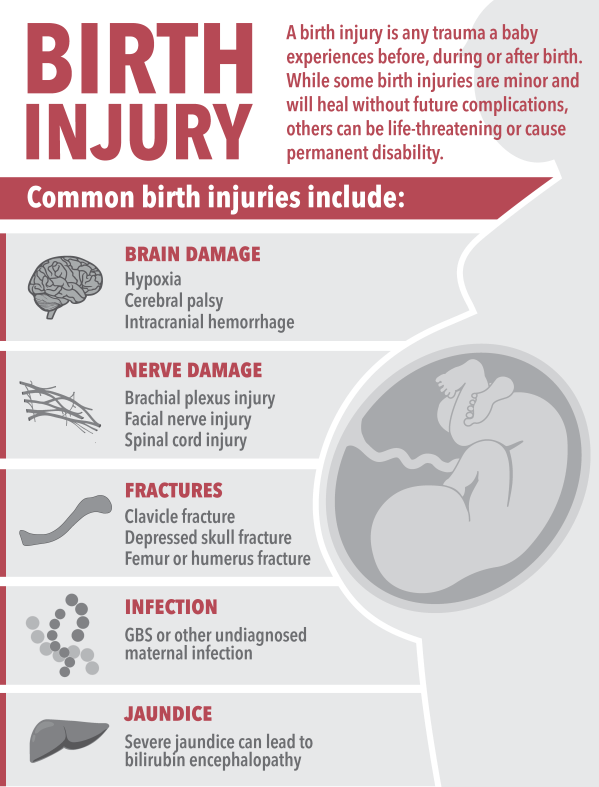Birth injuries are any type of harm which the baby suffers shortly after, shortly before, or during the birth. In the medical textbook, Merck Manual was said that many babies suffer from minor injuries during the delivery process. In most cases, these injuries do not need to be treated and they often heal by themselves. But, it is noticed that most birth injuries can lead to serious complications, permanent disabilities, and disfigurement, especially if they are not treated immediately.
When birth injuries are left untreated, then they can develop into severe consequences and this can lead your child to have a brain trauma or paralysis. Some symptoms of birth injuries can be seen while your baby is still in the hospital. But, on the other hand, some signs of birth injuries are not seen until your baby develops, so they are noticed when your baby is grown or when he or she begins with school. Although some symptoms take a time to show, there are few symptoms that can be detected immediately and they can indicate that your baby has birth injuries.
Symptoms that are immediately apparent:
Contents

There are some symptoms that are classified as immediately apparent. But, you need to remember that the mentioned symptoms can be symptoms of other health conditions. This is a reason why you should talk with your doctor, to check if your baby has birth injuries, so in this way, you will avoid concluding birth injury on your own.
Action symptoms:
Here are given some symptoms which are related to the action of your baby, so you will know if your baby might have a birth injury.
- Seizures
- Arched back while crying
- Light sensitivity
- Breathlessness
- Lethargy
- Difficulties with sucking, eating, and swallowing
- Nausea, vomiting
- Excessive drooling
- Grunting and/or high – pitches crying
- Excessive fussiness for no apparent reason
Some of the below-mentioned symptoms may not necessarily appear as an action from your baby. Instead, these symptoms can be detected via other health issues. For example, your baby might not be exhibiting behaviors outwardly that something is wrong with him, but the general health is communicating that something is not okay. Here are some of the most common health-related symptoms of birth injuries:
- A paleness and/or wax-like appearance to the skin
- Anemia
- Jaundice
- Fever
- Wheezing
- Changes in vision
- Headaches
- Constipation
- High–frequency hearing loss
- Poor weight gain
- Dizziness
- Persistent coughing
- Low oxygen levels in the blood
- Low heart rate
- Inflamed nasal passages
- Hypertension or hypotension
It is noticed that in most cases, babies demonstrate symptoms that are both health-related and action–related, as well as muscle and bone-related symptoms.
Muscle and bone symptoms:
When your baby has birth injuries, then they can be related to their muscles and bones too. Here are some of the most common muscle and bone symptoms of birth injuries in babies:
- Favoring one side of the body
- Arm and/or hand bent towards the body
- Hairy patch on the back
- Its hand may curl up and take on a claw-like shape
- Writhing movements
- Skull fractures
- Weak or absent reflexes
- Spasms
- Weak movements
- Muscle stiffness or looseness (muscles may alternate between the two)
Symptoms that may surface between 12 – 24 months of age:
As we have said earlier, not all symptoms of birth injuries happen immediately. The birth injury may have happened after, during, or just before delivery, but the body takes time to demonstrate its symptoms, sometimes into toddlerhood. The most common birth injuries which happen during the toddler years are including:
- Difficulties in dressing alone, potty training, and grasping spoons to eat
- Ataxia (which is a loss of the full use of bodily movements)
- Speech problems
- Delay in the motor skill development
- Poor control over coordination
- Difficulties in walking normally
- Lack of muscle control
- Intellectual disabilities (difficulty with logical thinking, difficulty problem solving, explosive traumas, inability to connect actions to consequences and memory)
- Involuntary pulling of the neck
- Difficulties with a problem–solving
Developmental milestones:
One of the major indications that the infant, toddler, and children have a birth injury is the frequent miss of developmental milestones. Below are explained the developmental milestones and the average age at which most children reach these milestones:
2 – 4 months old:
- Pushes on elbows if lying on stomach
- Turns head when noises are heard
- Can reach and grasp objects
- Coos and smiles
- Holds head up
- Follows people with eyes and recognizes faces
6 – 9 months old:
- Understands different words and sounds
- Brings objects to mouth
- Takes down weight on legs when standing, with assistance
- Looks around easily at nearby objects
- Begins to crawl
- Turns over from back to front and front to back
- Can pick up small things with fingers
- Sits alone without assistance
- Can hop when standing on the ground, with assistance
1 year old:
- Starts to say words
- Explores and finds hidden objects
- Understands simple instruction, such as putting something in the thrash
- It might be able to walk or can walk while holding on to furniture
18 months old:
- Indicate to objects they want to play with
- Can scribble alone
- Understands one-step instructions
- Stands and walks
- Can say a variety of single words
- Drinks from a cup without assistance
- Eats with a spoon without assistance
2 – 3 years old:
- Can dress and undress without assistance
- Knows body parts and is familiar with family members
- Knows and says name and age
- Begins to complete sentences and understand rhymes
- Can draw straight lines and circle shapes
- Can run and kick a ball
- Walks up and down stairs without assistance
4 – 5 years old
- Climbs without assistance
- Uses the toilet without assistance
- Can bounce and stand on one foot for short periods of time
- Understand basic grammar and songs
- Begins to cooperate with other kids
- Retells favorite stores
- Uses scissors
You need to remember that only a physician can diagnose disorders and disabilities of your children, so you should not give conclusions on your own.
Symptoms that may reveal years later:
You should know that not all symptoms of birth injury will appear during the infancy and toddler years. Some children live with a birth injury, which is not known for them and their parents until they start with school. Symptoms that children see years later are typically cognitive–related, which are including problems with fine motor skills and developmental disabilities, such as autism, ADD/ADHD, Asperger’s syndrome.
Causes:
Birth injuries can be caused by medical problems with the mother or fetus, or by medical malpractice. Below is given a description of the most common causes of birth injuries:
- Maternal health factors: The abnormal pelvis shape, diabetes or maternal obesity can make delivery harder and they can increase the risk of birth injury.
- Fetal health factors: If the fetus develops an infection, loses oxygen or blood flow during delivery, or is born feet – first, then the risk for birth injury is increasing.
- Medical malpractice: The fail to diagnose a dangerous medical condition, improperly medicating the mother, or forcefully using medical tools, can cause the baby to suffer from a birth injury. All of the mentioned problems can be prevented if doctors follow a proper procedure.
Risk factors:
Below are given some of the most common risk factors for birth injuries:
- Fetal size: If the baby is prematurely born, then it has more risk for birth injury because it is very fragile and some babies may have underdeveloped bodies. Also, babies who are larger than average size for their gestational age, have an increased risk for birth injuries. This condition is known as fetal macrosomia and it is generally characterized by a birth weight over 8 pounds, 13 ounces.
- Instrumental deliveries: Instrumental delivery, which is also known as assisted delivery, can increase the risk of birth injury. The primary tools which are used for instrumental delivery include forceps and vacuum extractors.
- Abnormal delivery presentation: If the baby is not delivered with the head first, then he or she has increased chances of having a birth injury. The doctor can see your baby while it is in the womb, so if it is necessary, make a C – section and reduce the risk for birth injury.




